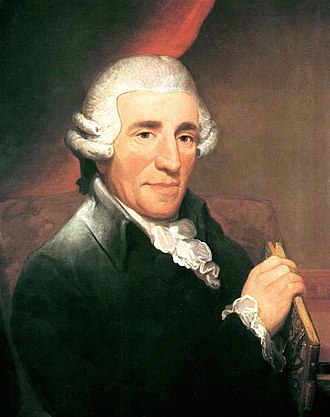Joseph Haydn
Portrait of Joseph Haydn by Thomas Hardy (1791)
(31 March[n 2] 1732 – 31 May 1809) was an Austrian composer of the Classical period. He was instrumental in the development of chamber music such as the piano trio[2] and his contributions to musical form have earned him the epithets "Father of the Symphony" and "Father of the String Quartet".
He was a friend and mentor of Mozart, a teacher of Beethoven, and the older brother of composer Michael Haydn
Symphony No. 88 in G major (Brüggen)
The symphony is set in 4 movements:
1. Adagio - Allegro (0:00)
2. Largo (6:53)
3. Menuetto: Allegretto (12:21)
4. Finale: Allegro con spirito (16:55)
Performers: Orchestra of the 18th Century, conducted by Frans Brüggen
The Symphony No. 88 in G major (Hoboken 1/88) was written by Joseph Haydn. It is occasionally referred to as The Letter V referring to an older method of cataloging Haydn's symphonic output.
The symphony was completed in 1787. It is one of Haydn's best-known works, even though it is not one of the Paris or London Symphonies and does not have a descriptive nickname.
Movements
The work is in standard four movement form and scored for flute, two oboes, two bassoons, two horns, two trumpets, timpani, continuo (harpsichord) and strings.
1. Adagio - Allegro 0:42
2. Largo 9:57
3. Menuetto: Allegretto 17:14
4. Finale. Allegro con spirito 21:39
The first movement begins with a brief introduction which quickly settles to the dominant chord to prepare for the main body of the movement. The strings open the Allegro stating the main theme and the rest of the movement develops from there, with almost every statement deriving from a previous idea. The exposition is monothematic and the development continues to make use of that single melodic idea. In the recapitulation, the initial statement of the theme is embellished by a solo flute.
The slow movement in D major consists mainly of embellishments of the legato oboe theme which opens it, though every so often is punctuated by chords played by the whole orchestra. After hearing this slow movement, Johannes Brahms is said to have remarked, 'I want my Ninth Symphony to sound like this'.
It is the first of Haydn's symphonies to use trumpets and timpani in the slow movement.
Mozart had previously used trumpets and timpani in the slow movement of his Linz Symphony.
The minuet is in G major. The trio has an unusual feature to it: after stating a rather simple theme, the fifths held in the bassoons and violas shift down a fourth in parallel, an effect typically avoided by the classical composers.
The finale is a sonata-rondo, with the rondo theme first presented in binary form. The first section of this is noteworthy for ending on unusual cadence on the mediant. A "perpetual-motion finale," it is considered one of the most cheerful Haydn ever wrote.
'♣ 음악 감상실 ♣ > [ Haydn ]' 카테고리의 다른 글
| Franz Joseph Haydn (1732-1809).-Double Concerto for violin, piano and string orchestra in F major Hob XVIII:6 (1766). (0) | 2017.06.21 |
|---|---|
| Joseph Haydn - The Complete London Symphonies 93-104 (0) | 2017.06.20 |
| Haydn - Trio for flute, cello, and piano in G major, Hob. XV:15 (0) | 2016.09.19 |
| Joseph Haydn - Organ Concertos (0) | 2016.09.05 |
| Joseph Haydn - string quartet op.33, no 3 "The Bird" (0) | 2016.08.28 |
